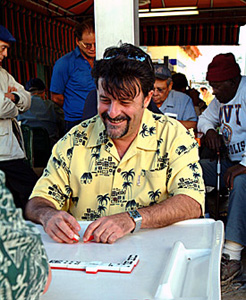
How do you play Cuban Dominos?
Three Guys From Miami Show You How to Make the Best Cuban, Spanish, and Latin American Food!
CHECK OUT THE RECIPES:
Drinks | Appetizers | Salads | Main Dishes
Soups | Side Dishes | Desserts | Index

There must be a hundred different ways to play dominoes. However, the Cuban Game is unique and we preserve the original rules here. Master these rules and you can feel comfortable playing the game on Calle Ocho or even in Havana.
In all of Cuba, Double Nine (55-piece dominoes) is the most widely played version of dominoes, except for Santiago de Cuba where they traditionally play Double Six (28-piece dominoes).

- Part of the "regular crowd" of Los Veteranos play at Domino Park on Calle Ocho in Miami.
In the beginning, each player picks one ficha from the 15 pieces that were set aside. Whoever gets the ficha with the highest number gets to go first. It is traditional to begin the game with the double nine, if you have it. However, any ficha can be played first. It does not have to be a double. Obviously, it's nice to get rid of a high value ficha early!
The four fichas drawn to select the first player are returned to the extras pile. They, and the rest of the extras, are out of play and NEVER played again.

As in most games of dominoes, each player tries to match the dots on one end of a ficha from his hand with the dots on an open end of any ficha on the board. There are always two and only two open ends where a play can be made. (There are no "spinners" in Cuban dominoes.)
If a player can't make a match from his hand, the player passes his turn ("Un Pase") to the player on his right (counter clockwise). Each player may play only one tile per turn.
Unlike some versions of dominoes, playing a double has no special significance. The player does not have the right (or obligation) to play another tile. Remember, only one tile can be played in each turn! However, a double is traditionally laid perpendicular to the tile it matches -- forming a "T" shape.
Play continues until one player runs out of dominoes. You might hear the winner call out "Domino!" However, you are much more likely to hear the losing team call out a Spanish expletive or two.
If none of the players can make any more plays, the game also ends. Each player counts the value of the remaining fichas in his hand and the person with the lowest total wins -- the team actually wins as the partner "rides along" on the victory of his partner.
Set Up
Determing Who Goes First
How to Play
Cuban Dominoes is a blocking style of dominoes. Much of the strategy involves counting fichas, guessing what fichas your opponents have in their hands, and playing fichas that put up "Tranques" or blocks that prevent your opponents from making a play.
Obviously, it is wise to get rid of high-numbered fichas in your hand when possible, because the losing team is penalized based on the total of all fichas remaining in their hands .
.
There are a finite number of tiles and numbers. An obvious strategy is to play to your strongest numbers. If you look at your tiles and see that you have several tiles with fives, for example, you can assume that the other players do not have as many. So you (with the help of your teammate) will want to play to your strength and use your advantage to force your opponents to pass. A common mistake is to hit or block your own strong number. Remember, once a block is set (in our example with a five) you want to maintain the block as long as possible.
Because it is played by teams, you must make your plays complement your partner's hand. In general, the player who leads with the first tile sets the strategy for the game. The partner should then try to follow this lead as much as possible. Avoid hitting the tile played by your partner unless you have no other choice. A major mistake is to kill your partner's Salida by playing a ficha that blocks his next play.
The tiles you play initially provide clues to your partner (and vice versa). Consistency in play helps keep you and your partner on the same page. Once you start playing to a number, you need to repeat that play as much as possible. This also works to "bleed" the player (your opponent) on your left of tiles with that number.
If you and your partner continue to control play you will eventually force this player to pass.
Finally, there will be instances where you have a stronger hand than the leader. Your partner will quickly realize this and send you clues, through his play, to this effect. You then need to take the lead and play to your hand, with your partner now following you.



